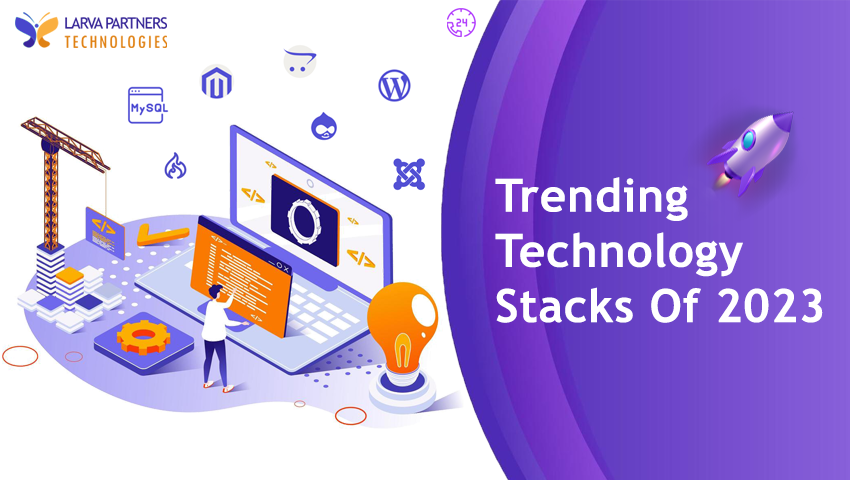
- January 11 2023
- larvapartners
What is a technology stack?
A technology stack, also known as a software stack or development stack, is a data ecosystem that enlists the underlying tools, frameworks, and libraries used to build and run your application. For instance, Facebook’s exhaustive application stack includes PHP, React, GraphQL, Cassandra, Hadoop, Swift, and a host of other frameworks.
A tech stack is broadly divided into two: client-side (frontend) and server-side (backend). While backend technologies include web frameworks, programming languages, servers, and operating systems, frontend technologies include HTML, CSS, JavaScript, and UI frameworks and libraries.
Web Development Stack Technology
To keep up with market changes and the caliber of web apps, web developers are expanding the capabilities of their web development stacks.
The appropriate collection of tools are essential to the successful creation of commercial software, while the wrong web development technologies might ruin a project. The correct appeal is provided by the technology stacks in today’s applications. They are used by developers to improve the usability, aesthetics, and scalability of mobile and web applications.
Web Development Stack
A solutions stack, data ecosystem, or technological infrastructure are further names for a web development technology stack. It is a collection of software tools or services used by application developers to build and run applications.
Client-side (frontend) and server-side are two broad, equally significant elements of a tech stack (backend).
Libraries, HTML, CSS, UI frameworks, JavaScript, catching tools, testing tools, and deployment software are some of the components found in frontend tech stacks.
Various software classes, including programming languages, operating systems, web frameworks, servers, databases, caching systems, containerization tools, etc., are included in backend technologies.
Major Web Development Technology Stacks
It Stands for,
MongoDB – NoSQL database
Express.js – backend web framework
Angular.js – frontend web framework
NodeJS – cross-platform, open-source server
One of the most popular software tools for developers is the MEAN stack, which is based on the single programming language JavaScript.
This feature makes it possible for app developers to utilise a single language throughout the whole development process, promoting code reuse and preventing needless reinvention. The fact that MEAN is based on free and open-source software and that users can get assistance from the support community is another advantage.
Since MEAN stack apps are scalable, adaptable, and expandable, you may utilise them for cloud hosting (designed to allow developers to add new functionalities and capabilities). In essence, MEAN is a wonderful web development technology stack for creating a wide range of websites and apps that are quick, extremely efficient, and interactive.
LAMP stands for:
Linux – the operating system
Apache – HTTP server
MySQL – database management tool
PHP – Perl or Python programming language
Our list of the key web development technologies includes LAMP since it is affordable, adaptable, and efficient. The stack is not only reliable, but it is also easy to use and powerful enough to create unique online applications.
Because it is free and open-source, you can use it with virtually any operating system. Other LAMP components can be changed or swapped out to create a product that satisfies particular business requirements.
Several operating systems (OS) support LAMP, including Linux, Microsoft Windows for the WAMP stack, and Mac OS for the MAMP stack. PHP can also be substituted for the programming languages Perl or Python. Drupal and WordPress are two popular open-source content management systems (CMS) that use LAMP.
MongoDB – NoSQL database
Express.js – backend web framework
React.js – frontend web framework
NodeJS – cross-platform, open-source server
MERN’s React integration is its distinguishing feature, and it leverages codes on servers and browsers to make it a top web development technology stack. Additionally, R has a frontend and backend development framework as well as a potent library for creating sophisticated, interactive user interfaces (UIs).
MERN is economical, excellent for UI rendering and performance, but it works best for small-scale applications with low productivity requirements.
MongoDB – NoSQL database
Express.js – backend web framework
Vue.js – frontend web framework
NodeJS – cross-platform, open-source server
Vue.js is simple to learn, offers a clear programming UI, and integrates the features of both Angular and React. It also produces excellent web apps.
With Vue, you get a robust stack and excellent performance by combining the best aspects of React and Angular. In fact, MEVN stands out as a cutting-edge method for creating robust and dynamic web apps while enhancing website functionality.
The objective of serverless stacks, which are the cloud’s equivalent in terms of infrastructure, is to improve the responsiveness, scalability, and business development and transformation of your IT programmes.
Serverless technology is being used more and more by businesses to create serverless apps. Additionally, the stack offers better infrastructure management to scale up and scale down in response to fluctuations in service demand.
Platforms for serverless computing give you the ability to manage your infrastructure with ease because they include a variety of tools and services for web development.
Due to its outstanding characteristics, such as the ability to produce appealing and useful apps utilising the same business logic and UI, Flutter is one of the top web development technology stacks.
The open-source Flutter stack programme is used to create software for platforms like iOS, Android, Mac, Linux, and Windows. One codebase can be used to create all apps.
Flutter Engine, Dart, Foundation Library, and design widgets are some of the components of the stack.
Using Flutter can ensure you money and time savings, good app performance, and a welcoming development community despite its large file sizes, constrained tools and libraries, and lack of support for password managers.